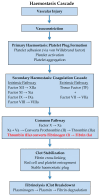Severe Hereditary Hypofibrinogenemia in Pregnancy: A Case Report of a Novel Obstetrical Management with Thromboelastometry Guided Fibrinogen Supplementation
- PMID: 40647670
- PMCID: PMC12248511
- DOI: 10.3390/diagnostics15131671
Severe Hereditary Hypofibrinogenemia in Pregnancy: A Case Report of a Novel Obstetrical Management with Thromboelastometry Guided Fibrinogen Supplementation
Abstract
Background and Clinical Significance: Hereditary Fibrinogen Disorders (HFDs) are a group of rare, inherited coagulation disorders with a wide spectrum of clinical presentations, ranging from asymptomatic cases to severe bleeding or thrombotic events. Among these, hereditary hypofibrinogenemia (HH) poses particular challenges in obstetric care due to its unpredictable course and limited evidence-based guidelines. Case Presentation: This case report describes the novel obstetrical management of a 37 years old multiparous woman with severe HH (SHH) guided not only by fibrinogen levels but also by rotational thromboelastometry (ROTEM®), a global test of hemostasis using specific parameters such as FIBTEM® and NATEM® assays. Despite persistent low fibrinogen levels during labor and peripartum (<100 mg/dL), favorable maternal and neonatal outcomes were achieved by relying on ROTEM®-based parameters to guide clinical decisions. Conclusions: Current recommendations for managing pregnancies in women with HFDs are largely based on expert consensus and exclusively use fibrinogen levels. This case supports the use of specific assays (FIBTEM® and NATEM®) of the ROTEM® global test of hemostasis as valuable tools in the obstetric management of women with HH. The use of FIBTEM® and NATEM® assays could provide individualized perinatal care, avoiding unnecessary therapeutic interventions and aiming for optimal perinatal outcomes.
Keywords: FIBTEM®; NATEM®; ROTEM®; hereditary hypofibrinogenemia; pregnancy.
Conflict of interest statement
The authors have no relevant financial or non-financial interests to disclose.
Figures
Similar articles
-
Thromboelastography (TEG) or thromboelastometry (ROTEM) to monitor haemostatic treatment versus usual care in adults or children with bleeding.Cochrane Database Syst Rev. 2016 Aug 22;2016(8):CD007871. doi: 10.1002/14651858.CD007871.pub3. Cochrane Database Syst Rev. 2016. PMID: 27552162 Free PMC article.
-
Maternal and neonatal outcomes of elective induction of labor.Evid Rep Technol Assess (Full Rep). 2009 Mar;(176):1-257. Evid Rep Technol Assess (Full Rep). 2009. PMID: 19408970 Free PMC article.
-
Thromboelastography (TEG) and rotational thromboelastometry (ROTEM) for trauma induced coagulopathy in adult trauma patients with bleeding.Cochrane Database Syst Rev. 2015 Feb 16;2015(2):CD010438. doi: 10.1002/14651858.CD010438.pub2. Cochrane Database Syst Rev. 2015. PMID: 25686465 Free PMC article.
-
Epidural therapy for the treatment of severe pre-eclampsia in non labouring women.Cochrane Database Syst Rev. 2017 Nov 28;11(11):CD009540. doi: 10.1002/14651858.CD009540.pub2. Cochrane Database Syst Rev. 2017. PMID: 29181841 Free PMC article.
-
Methods for blood loss estimation after vaginal birth.Cochrane Database Syst Rev. 2018 Sep 13;9(9):CD010980. doi: 10.1002/14651858.CD010980.pub2. Cochrane Database Syst Rev. 2018. PMID: 30211952 Free PMC article.
References
Publication types
LinkOut - more resources
Full Text Sources


